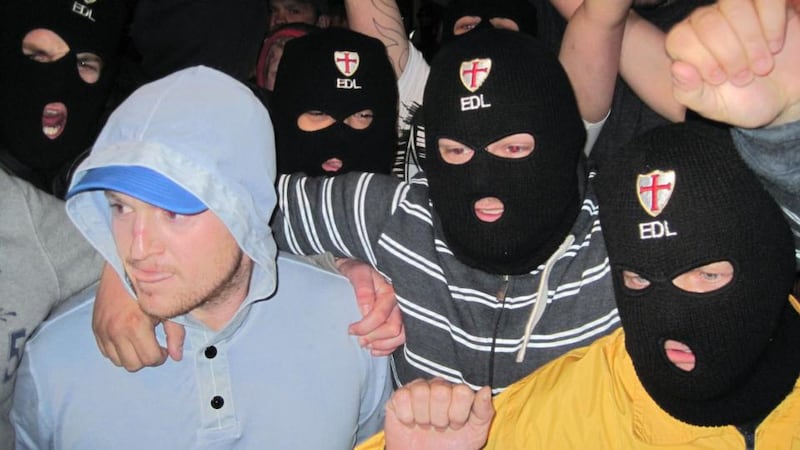“Ignore what they say. Irish people love me and want me here,” prominent British far-right agitator Tommy Robinson told his social media followers on Thursday after flying into Dublin.
“Ireland loves me and I love Ireland,” he posted later in the evening along with a video of a street busker in Killarney singing his name.
Robinson (40), who real name is Stephen Yaxley Lennon, says he is in Ireland as a “journalist” to document the growing anti-immigration movement here.
Not everyone will agree that he is loved in Ireland, even by some of the people that one might expect. As well as the expected backlash from left-wing and antiracism activists, the arrival of the former leader of the English Defence League has been met with dismay by many on the Irish far-right who believe his notoriety is such that he will further alienate their movement from the mainstream. Some prominent anti-immigration campaigners have even suggested he is a “plant”, sent to Ireland to discredit their movement at a time when it is finally finding new adherents.
Derek Blighe convicted and fined after refusing to make donation to Irish Refugee Council
High Court awards Peter Casey €140,000 damages for defamation in acupuncturist’s online post
Economists need to get their story straight on immigration
Judge halts man’s challenge to law enabling expedited development of asylum seeker housing
“All in all it can be safe to assume Robinson is at best an idiotic loyalist who doesn’t understand he is not welcome in Ireland and is a hindrance to the movement or, the more likely scenario, that Robinson is here to gather intelligence and derail a growing Irish Nationalist movement,” one far-right telegram account said on Thursday.
Others pointed to Robinson’s previous anti-Irish comments and his support for British soldiers involved in the Bloody Sunday massacre.
However, despite the less-than-warm welcome, the arrival of Robinson, whose mother is Irish, shows the increasing co-operation between the British and Irish far-right movements in recent months as anti-immigration protests gathered steam nationally.

This co-operation involved group meetings on social media involving Irish and British campaigners and the sharing of tactics designed to get their anti-migrant message into mainstream conversations.
Gardaí are aware of many of these contacts, including extensive communications between Irish leaders and members of the British fascist group Patriotic Alternative, which in the last three years has become increasingly adept at recruiting young people through social media.
Gardaí are also aware Robinson, who is not a member of Patriotic Alternative, was in extensive contact with Irish activists before his visit here.
Irish far-right activists have eagerly adopted tactics that have proven effective in the UK, including the dissemination of false information about criminal activity by foreign nationals.
“We’ve seen a massive rise in fake news being spread on social media accusing refugees of being engaged in all sorts of things,” said one security source. These often involve accusations of sexual assault or harassing women, they said.
They pointed to false accusations, which spread widely on social media late last month, that a migrant raped a woman in Finglas. This led gardaí to take the highly unusual step of publicly stating the suspect they were searching for was a white, Irish male.
Nevertheless, a large group of anti-immigration protesters gathered outside Finglas Garda station demanding action.
Also last month, a video of a man running up a Dublin street was spread widely online with the caption saying he had been sexually assaulted by migrants. Gardaí have no record of such an incident.

Vague accounts of migrants or people with dark skin harassing women or loitering menacingly are spread daily across various Irish social media accounts. Supporting evidence or details of a garda complaint are rare.
“We’ve never seen this [here] before at this level. It’s a mirror image of what has been happening in the UK,” said the security source. “Then the guards are accused of not doing anything. But you can’t do much if there’s no complaint or if nothing actually happened.”
These accounts are mixed with real accounts of crimes committed by foreign nationals, which are often heavily embellished.
In other instances, videos of violent behaviour by Irish people are shared with claims that the perpetrators are foreign nationals. Earlier this month, a video of an Irish youth pushing a woman off a Dart platform on to the tracks was widely shared online with claims the teenager was a migrant and that the event occurred recently. In fact the video dates from 2021 and the attacker has already been convicted.
This spread of false information online reached new heights during the pandemic before being adapted for anti-immigration purposes, researchers have found. According to a report from the European Commission’s Radicalisation Awareness Network, “extremist groups capitalised on the [pandemic] by offering simple solutions and answers to highly complex issues with the aim to advance their agendas and recruit followers.”
Other tactics borrowed from the UK include the distribution of fake leaflets designed to inflame community tensions. Earlier this week photographs of a leaflet purporting to be from the “The Irish Centre for Diversity” and “Ralltas nd hEireann” (an apparent misspelling of Rialtas na hÉireann, the Irish Government) were spread across Irish social media.
The official looking document read: “Girls to stay indoors after 6pm (until further notice). New arrivals to this area are not accustomed to Irish cultural norms at this transitionary time. Thank you for your compliance.”
Some social media users claimed they were being distributed in Ballymun and Athy, two areas where asylum seekers are being accommodated, although The Irish Times could not confirm anyone had received a physical copy. However photos of the leaflet were widely shared online by various far-right leaders.
“We are not associated with the leaflet in any way and the unauthorised use of our name has been reported to An Garda Síochána (Ireland’s Police and Security Service),” said the Irish Centre for Diversity, a business that advises organisations on diversity issues. The Government also confirmed it had nothing to do with the leaflet.
Even more sinisterly, another fake leaflet shared online this week asked people planning to attend today’s antiracism rally in Dublin to “come show your support” for a man who will face court charges over an allegation of murder.
The antiracism solidarity march is organised by the Ireland for All coalition, which includes groups such as the National Women’s Council of Ireland, Fórsa and SIPTU.

Regarding Robinson, it remains to be seen what impact his visit will have. Gardaí had been concerned he might provoke further unrest or even violence around protests. By Friday, they were less worried. “Most of the people who might have welcomed him seem to now wish he’d go home,” said one source.
So far on his visit, Robinson has kept a low profile. One of his first actions was to visit a known drug dealer in the Ballyfermot area and pose for a photo with him. He later took a train to Kerry where he was seen socialising.
Not everyone is unhappy to see the UK man, however. “Belated 1000 welcomes to Éire Tommy Robinson,” said Dara Flaherty, a far-right activist who had led demonstrations outside politicians homes and who was charged in 2021 with breaching Leinster House security. “Consider yourself royalty in Galway,” said O’Flaherty.
“I will be in touch, brother,” responded Robinson.




